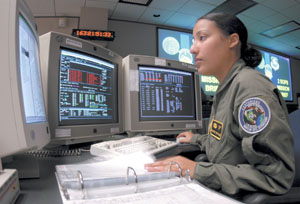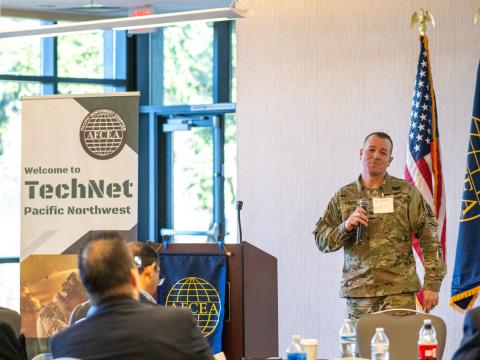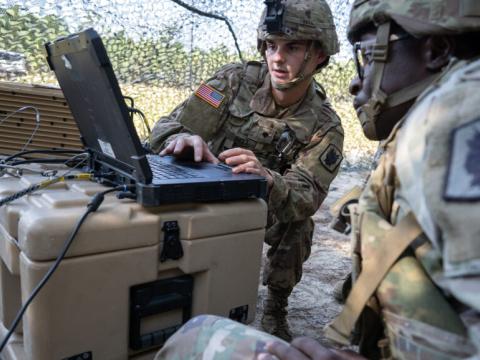Data Rides on Beams of Light
 |
| Senior Airman Nayibe Ramos, USAF, satellite system operator, 2nd Space Operations Squadron, Schriever Air Force Base, reviews a global positioning system checklist of satellite operations. The base operations center controls a constellation of 29 orbiting satellites that provides navigation data to military and civilian users worldwide. Work on laser-based communications now underway through the Defense Advanced Research Projects Agency will expand the use of satellites and allow warfighters to communicate at multigigabit-per-second speeds. |
A team of researchers from industry, academia and the U.S. Defense Department is creating high-speed, long-range communication technologies that will help eliminate the fog of war and take the element of surprise away from the enemy. The secure laser-based system will offer communication uplink speeds in the multigigabit-per-second range and will improve tracking so communications can be transmitted to satellites from mobile platforms. The research also will lead to aberration-free three-dimensional imaging at distances of more than 600 miles.
The Defense Advanced Research Projects Agency (DARPA), Arlington, Virginia, is sponsoring the work on the Coherent Communications, Imaging and Targeting (CCIT) Program. Lucent Technologies’ Bell Labs and the New Jersey Nanotechnology Consortium, both in Murray Hill, New Jersey, lead the research team that includes scientists from several corporations, two universities as well as Sandia National Laboratories and Lawrence Livermore National Laboratory. Researchers moved into Phase II of the project this spring, and the work is scheduled for completion by March 2006. The U.S. Air Force will conduct field demonstrations of the technology shortly thereafter.
Dave Bishop, vice president of nanotechnology, Bell Labs, describes the concept of the system as a rubber mirror. “Imagine, for example, that you have a soda can and you stretch a balloon across the end of it to form a tight drum. Then you put some pieces of metal on it to make a mirror. When you reach up from the bottom of the can, you can pull that mirror and change its shape in a lot of different, complicated ways,” Bishop explains.
This construct results in a mirror that can be programmed in time, called a microelectromechanical systems (MEMS) spatial light modulator (SLM), he relates. It can be shaped to create different effects, while the surface remains essentially static. From above, the device, which is only a few inches in diameter, looks like a solid mirror; however, it actually includes millions of mirrors, each the size of a human hair. Each mirror comprises one pixel of an image and can be moved up and down like a piston. Electrodes attached beneath to each mirror control the movement.
Line of sight is required for communications; however, because the position of each mirror can be changed very quickly, the connection can be maintained even when attached to moving platforms such as aircraft. This freedom in movement will allow users to steer the micromirrors in a plethora of directions and, because of their diminutive size, data can be transmitted at a very high speed, Bishop explains.
Silicon micromachine technology will be used to create SLMs with a large degree of mechanical freedom, according to Bishop. “Essentially, a 777 airliner might have something like a quarter of a million parts. A more typical machine may have hundreds of thousands or tens of thousands of moving parts. This object will have millions of moving parts, so it’s easily going to be one of the most complicated mechanical devices ever built,” he says.
The CCIT system will improve data sharing in many places within the network because laser beams enable communication between platforms at a very high data rate, Bishop says. He compares this highly advanced technology to the rudimentary communications techniques employed during the past century when signaleers used light to send Morse code. The difference is that information could be sent at only about one bit per second using this method. Laser beams can be turned on and off billions of times per second, so a gigabyte per second of data can be transmitted. The result is very high-speed data pipes without the spectrum limitations of radio communications, he offers.
This capability is a building block to the Defense Department’s transformational communications efforts because it brings to the military the broadband access commercial customers enjoy, Bishop notes. “Up until now, all of the communications links that exist down to the soldiers and the tanks have been low-speed connections that are primarily voice-centric. But, just as in the civilian world of wireless data, Web browsing and wireless access, essentially that same thing is happening in the military world. So, what the military wants to be able to do is download real-time video to individual soldiers,” he explains. Using this technology, information from a satellite or unmanned aerial vehicle could be sent to warfighters so they can view what is ahead of them on the battlefield.
According to Bishop, the Defense Department envisions mounting this laser-based capability on satellites, aircraft and trucks. He allows that the systems also could be mounted on soldiers; however, at this time, other technologies may be more suitable at the level of the individual warfighter.
One challenge the CCIT technology addresses is communications on the move. Military operations are relatively fluid, with troops, vehicles and aircraft in nearly constant motion. Because the laser beams can be adjusted quickly, high-speed connectivity can be maintained, Bishop states.
“Every commander since the dawn of time has had to deal with the fog of battle. The high-speed links are making the fog of battle go away. Generals have never known where their troops are, never known what they’re facing, never known what their folks are up to, and battles were won or lost based on guessing. Once every soldier is connected with the high-speed link—a reliable, low-cost, high-speed link—essentially the fog of war goes away,” he says.
Bishop compares this capability to the Internet and how it allows ubiquitous communications regardless of time and space. “With this capability, the chairman of the Joint Chiefs of Staff can have a high-speed connection link to a soldier. If an individual soldier has a video camera mounted on his helmet, the chairman of the Joint Chiefs of Staff can see what the soldier sees in real time,” he says.
This technology can have far-reaching effects, he contends. It will influence how battles are fought as well as how warfighters are deployed because a smaller number of soldiers can be more lethal and more effective. “When you play chess, you know where your opponent’s pieces are and you know exactly where your pieces are, so you don’t get surprised. This will give the military the chance to look at the whole board, so there aren’t any surprises,” Bishop states.
Another issue the CCIT capability will address is how to build the right size network. When commercial organizations invest in networks, they must determine how much infrastructure to install to meet demand. Investing in too much infrastructure increases costs and reduces revenue. But investing in too little can create problems during peak demand times. The military must build dynamic and flexible networks to meet the needs of diverse operations and troop configurations. The CCIT system not only meets these requirements, but also is self-healing in that messages can be routed through a different path should a portion of the network go down.
One advantage of the CCIT systems from a purely military standpoint is that the beams are focused. “When you’re communicating using lasers, you’re not radiating everywhere. I could be standing right next to you, and the laser beam is going to somebody else’s view, but I won’t know about it. Radio waves tend to leak out everyplace. So when you broadcast radio waves, you’ve given away your location,” he says. The technique also is not susceptible to electronic warfare, so it is in effect impossible to jam, he adds.
The second phase of the program takes the technology from research in the laboratory to manufacturing readiness. The work will involve creating mirrors with more degrees of freedom as well as decreasing the size and cost while increasing the speed of movement.
Researchers must overcome three primary challenges during this phase. By the end of the first phase, a 32 x 32 pixel SLM was demonstrated. The goal for the second phase is to develop a 256 x 256 pixel SLM. Bishop allows that the second challenge is the integration of the signal-processing electronics. Finally, because the devices will be used in military operations, packaging issues must be addressed that include ruggedization.
In approximately two to three years, the Defense Department should be able to design comprehensive systems that incorporate this technology then deploy them.
Bishop explains that in addition to military uses, the technology will have commercial applications for imaging in areas such as electronic ophthalmology. For example, a few years from now, an ophthalmologist could use the technology for vision examinations and create glasses or contacts based on precise data rather than the patient’s subjective feedback. In addition, the technology could be used in high-definition television or as a way to connect companies’ offices wirelessly.
Because the technology controls the phase of light, it also could be employed to build three-dimensional pictures, or holograms. Although fixed holograms can be built using photographic film, the CCIT system would enable the creation of electrically programmable holograms that then can be used to develop three-dimensional displays. The three-dimensional communications devices seen in the movie “Star Wars” is an example of how this technology would work, Bishop offers. He allows that research in this vein will not take place immediately, but it is the direction that scientists are heading.
As this technology develops, it will lead to quantum communications. Bishop predicts this could occur in approximately 10 years.




Comments